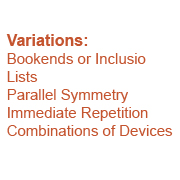Literary Structure Variations
Sometimes we can become so intent on finding chiastic structures that, when repetitions appear, we try to force them into the classical sandwich structure of chiasms.
Thematic repetitions are found throughout the Bible to help the reader grasp a concept through the use of recurring thoughts and actions.
A phrase may be simply repeated in similar or fuller terms to increase the passage's understanding; other times the structure is much more complex.
The A-B-C-C′-B′-A′ chiastic structure, with its unique center point emphasis, is just one type of thematic repetition.
When God inspired the Bible, He used a wide variety of thematic repetitions and literary devices to engage us in the greatest and most beautiful literary accomplishment of all time.
Comparisons and contrasts, in their many forms, allow us to see God's greater purposes.
Additional forms of literary structure include:
Parallel Symmetry
In Jerome Walsh's excellent book
Style and Structure in Biblical Hebrew Narrative
he identified many forms of literary structure.1
Using Walsh's terminology, two of the more common literary devices in the Bible are parallel symmetry and immediate repetition.
Parallel symmetry is structured as an A-B-C-A′-B′-C′ sequence where its themes are built up a second time with similar themes in the same order.
An A-B-A′-B′ structure, often identified as an alternating repetition, is essentially a parallel symmetry.
Example:
| A | If your right eye causes you to sin, (29a) | |||
| B | tear it out and throw it away. (29b) | |||
| C | For it is better that you lose one of your members (29c) | |||
| D | than that your whole body be thrown into hell. (29d) | |||
| A′ | And if your right hand causes you to sin, (30a) | |||
| B′ | cut it off and throw it away. (30b) | |||
| C′ | For it is better that you lose one of your members (29c) | |||
| D′ | than that your whole body be thrown into hell. (29d) | |||
| (Matt 5:29,30 ESV) | ||||
In parallel symmetry, there often is not an emphasis in the same way as the center point of a chiastic structure. Sometimes the last line of the sequence, such as D and D′ may be the point of emphasis; other times the passage that immediately follows the structure is the emphasis.
Immediate Repetition
In the A-A′-B-B′-C-C′ immediate repetition, a theme is repeated and then a second pair of repeating themes, and so on.
Example:
Isaiah 1:3 contains an A-A′-B-B′ immediate repetition: the two animals in the first part who know their master's heart are compared to the people of Israel that do not know or understand.
| A | The ox knows its owner, | |
| A′ | and the donkey its master's crib, | |
| B | but Israel does not know, | |
| B′ | my people do not understand. | |
| (Isaiah 1:3 ESV) | ||
By combining ox and donkey, you begin to get a picture of the type of animal being pictured. But when Israel and my people are combined, the picture becomes an analogy with a contrast. In English we could say, "Israel, you don't know your master's heart; even a donkey does!"; this symmetry carries more emphatic weight.
While immediate repetitions may be found throughout the Bible, I find them to be the least intriguing. If you think you have discovered an immediate repetition, I recommend you dig a bit deeper to see if another structure may be identified by combining the two parts of the structure.
Lists
A list is simply a sequence of items. Normally they have no specific order and are repetitions of the same theme. Genealogy lists are the major exception – they are presented in first to last order.
Example:
Regarding who will not inherit the kingdom of God, Paul wrote in 1 Corinthians:
1 neither the sexually immoral,
2 nor idolaters,
3 nor adulterers,
4 nor men who practice homosexuality,
5 nor thieves,
6 nor the greedy,
7 nor drunkards,
8 nor revilers,
9 nor swindlers
will inherit the kingdom of God. (1 Cor 6:9,10 ESV)
Lists may be combined with other literary structures such as a chiasm:
| A | Or do you not know that the unrighteous (9a) | ||
| B | will not inherit the kingdom of God? (9b) | ||
| X | Do not be deceived: neither the sexually immoral, nor idolaters, nor adulterers, nor men who practice homosexuality, nor thieves, nor the greedy, nor drunkards, nor revilers, nor swindlers (9c,10a) | ||
| B′ | will inherit the kingdom of God. (10b) | ||
| A′ | And such were some of you. (v11a) | ||
| (1 Cor 6:9-11a ESV) | |||
Other examples of lists are the genealogy of Jesus in Matthew 1, the blessings and curses in Deuteronomy 28, and the list of conquered kings in Joshua 12.
